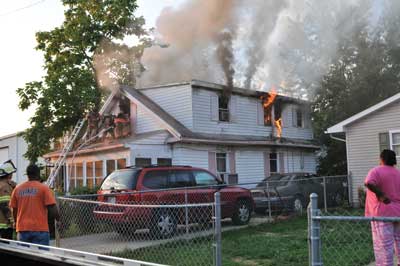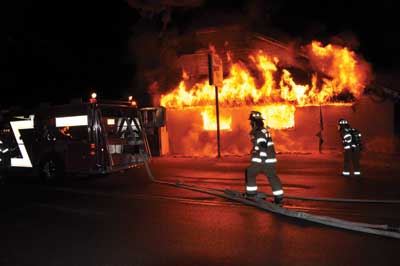BY JOHN M. BUCKMAN III
What are your strategic priorities when arriving on the scene of a structure fire with two or three interior qualified firefighters? Offensive or defensive? When will your next company arrive? What is the risk to the firefighter? What do we gain if we go offensive? What happens to the fire spread if we put water on it from the exterior with limited staffing? What will the outcome be if we try to go offensive but can’t sustain the attack and the fire continues to grow? How much fire could be extinguished with defensive operations? How much water is required and available?
These questions must be answered and a response formulated in about 15 seconds when arriving at the scene of the fire. Many articles and books on strategy and tactics usually include a staffing component of 12 to 16 firefighters for a single-family, one-story residential structure fire.
The first strategic consideration that needs to be put back into your incident commander (IC) toolbox is that fires can be suppressed by putting a sufficient volume of water on the fire quickly to absorb the British thermal units from wherever.
STRATEGIC DELIBERATION
- What’s the structure type, what construction materials are used, how much of the structure is involved in fire, and what is the color of the smoke?
- Are occupants accounted for? Are people at home? If so, are they trapped? When lives are at risk, even with limited staffing, our strategic choices and tactical implementation will be different than if no lives are at risk.
- What are the neighboring exposures? Are power lines down? Does the fire appear to be spreading?
- Is your staffing adequate to implement the tactical choices? There is nothing wrong with choosing a defensive strategy because the on-scene staffing is not sufficient to engage in interior structural fire operations.
Defensive operations can save contents and valuables inside the structure if they are aggressive and flowing lots of water in the right places. There is nothing wrong with a defensive choice when the risk to our firefighters is too great or the ability to mount an aggressive interior fire attack is not possible because of limited staffing.
SCENE SIZE-UP
![David Bretz, German Township (IN) Fire Department.]](https://emberly.fireengineering.com/wp-content/uploads/2013/12/1312fe-buckmanphoto1.jpg) |
| (1) Command must base the strategic priorities on a realistic response expectation. The strategic priorities at a home response depend on whether you can expect four or eight firefighters to arrive at the same time. [Photo by David Bretz, German Township (IN) Fire Department.] |
So many times, ICs have told me that nothing could be done because of inadequate staffing. You can take many tactical actions to prepare for the arrival of additional staff. We are not going to just stand around with three firefighters on the scene. Planning is critical in firefighting, even more so with limited staffing because we are unable to assign tactical tasks simultaneously. With limited staffing, you may have to assign tactical tasks sequentially, while other critical tasks will have to wait for initial crews to accomplish the first task or for the arrival of additional staff.
Request adequate staffing resources early, and request more than you think you might need. In many areas where limited staffing impacts our strategic and tactical choices, the arrival of additional staffing may be 20 to 30 minutes away. If you delay requesting additional resources, you will severely limit your choices. The IC may delay the request for additional resources for many reasons, but none are valid. If the IC is dispatched to a structure fire knowing that staffing is fewer than 12 to 16 firefighters, he has a moral obligation to his firefighters to request additional resources at that moment. Don’t let ego, competition with neighboring fire departments, or fear of chastisement stand in the way of requesting additional resources.
Offensive Strategy and Tactical Choices
 |
| (2) Command must maintain a good visual perspective (not just of the A side) and aggressively seek interior reports and information from other crews. (Photo by author.) |
- Park close enough for the crosslay to reach throughout the home to the fire area but far enough from the home to avoid damage from a structural collapse or from the intense heat.
- Without additional staffing, adding more hose to the line will be difficult.
- Place apparatus into pump gear before exiting the cab, and set the wheel chocks.
- The driver completes a 360° survey before choosing a strategy and implementing tactical operations. The driver communicates the action plan through the communications system and requests a second alarm.
- If choosing an offensive strategy, pull a 1¾-inch preconnect and stretch it to the appropriate location. Charge the handline, set the proper pressure, and engage the automatic pump governor (you have 2,300 gallons of water).
- Prepare for entry by donning self-contained breathing apparatus (SCBA). The driver will check for any immediate internal and external exposures. Personnel should also consider whether they are qualified when deciding whether the crews should go inside the structure. Consider the crew members’ training, experience, and fitness levels, especially when there are only two or three firefighters on the scene.
First-due tanker parks on scene within one hose length of the engine (50 feet).
- Always remember in positioning the tanker that engines may have ladders that come out from the rear.
- Put the pump into gear.
- The driver dons appropriate personal protective equipment (PPE) (depending on the strategy chosen) and meets the engine driver.
Interior operations.
- Perform a primary search for the victim; locate the victim and remove him. The tactical considerations for a rescue include what action will best help to achieve the rescue objective (e.g., attack the fire, vent the building, or go for the victim; go through the front door or up a ladder).
- Sometimes, as Deputy Chief (Ret.) Vincent Dunn from the Fire Department of New York says, putting the fire out takes care of 90 percent of the problem. There is some truth to that, but it will not always be the first objective, so think about what action performed first best meets the rescue objective.
- Control the fire if it is within 15 feet of the exterior door; retreat to defensive operations if access to the fire requires penetration of more than 15 feet into the building.
Third-arriving person/crew.
- Advise the interior crew of exterior smoke/fire conditions. Sound the evacuation signal if necessary. Request a second alarm if it has not already been requested.
- Check the pump panel of the engine for proper pressure, and increase the pressure from the tanker in the supply line to the engine. Open the intake valve, monitor the residual pressure on the gauge, and refill the water tank on the engine as the water supply allows.
- Don PPE including SCBA for emergency rescue of firefighters.
- Control utilities.
- Set up positive-pressure ventilation.
Defensive Strategy and Tactical Choices
 |
| (3) The tactical options are limited; this structure was lost before the fire engine left the station. (Photo by author.) |
If there is no life hazard or if the home is vacant, set up for an exterior attack. Through a front door or a window, check the structural integrity; be cautious and look out for any power lines connecting to the home. Some additional defensive firefighting operational considerations include the following:
- – There is no savable life-i.e., anyone who is inside is dead because the building is fully involved or the smoke/fire conditions present are clearly not compatible with life.
- – Fire involvement that is compromising structural components (e.g., rafters, joists, studs, beams, and so forth).
- – The speed of the fire growth exceeds the resources available.
- Park close enough for the crosslay to reach throughout the home to the fire area but far enough from the home to avoid structural collapse and heat damage.
- If additional staffing does not arrive, adding more hose to the line will be difficult.
- Place the pump into gear before exiting the cab, and set the wheel chocks.
- The driver completes a 360° survey before choosing strategy and implementing tactical operations. Communicate the action plan through the communications system. Request a second alarm.
- If a defensive strategy is selected (choice A):
- – Pull a 1¾-inch preconnect and stretch to the appropriate location.
- – Protect exposures first, or use a window for applying streams.
- – Charge the handline, set the proper pressure, and engage the automatic pump governor (you have 2,300 gallons of water).
- If a defensive strategy is selected (choice B):
- – Deploy the blitz fire nozzle from the passenger side pump panel. Return to the pump and charge the line to blitz the fire. Set the pressure to 130 pounds per square inch for the preconnect line. This is not a 2½-inch handline since one person can’t safely deploy a 2½-inch handline.
- – Protect the exposures or deliver water to the interior through a window or a door.
First-due tanker parks on scene within one hose length of the engine (50 feet).
Remember that the engines have ladders that come out from the rear. The driver stretches and connects the hose from the engine to the tanker, providing water supply to support a defensive attack. Charge the line from the tanker to the engine.
- Don the appropriate PPE and move toward a 1¾-inch handline to assist with water application, or
- Pull a second 1¾-inch handline for exterior operations using a window or a door.
- The driver of the tanker may assist in removing exterior components of the structure, such as siding or windows, to facilitate extinguishment from the exterior.
- If the engine selected the blitz fire option, make sure all the water supply connections are good.
Third-arriving person.
- Complete a scene assessment by doing a 360° walk around the entire structure.
- Request a second alarm if it has not already been requested.
- Control utilities.
JOHN M. BUCKMAN III is the director of firefighter training for the State of Indiana. He has served 41 years as a volunteer firefighter and 35 years as chief at the German Township (IN) Volunteer Fire Department. He was president of the International Association of Fire Chiefs in 2001-2002 and founder and chair of the Volunteer and Combination Officers Section from 1990-1998. He is a co-author of the 3rd Edition of Recruiting, Training and Maintaining Volunteer Firefighters, editor of the Chief Officer’s Desk Reference, and co-author of Lessons Learned from Fire-Rescue Leaders.
Fire Engineering Archives

